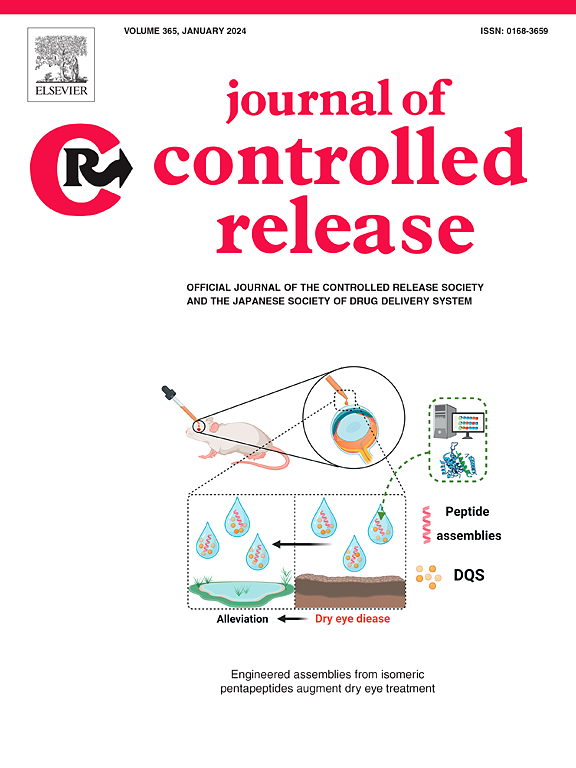Hematite-embedded mesoporous nanoparticles for ferroptosis-inducing cancer sonoimmunotherapy
IF 11.5
1区 医学
Q1 CHEMISTRY, MULTIDISCIPLINARY
引用次数: 0
Abstract
Sonodynamic therapy (SDT) aims to treat cancers by generating reactive oxygen species in response to ultrasound (US). However, the clinical applications of SDT are often constrained due to its limited efficacy in triggering systemic immune responses. Considering this, we developed hematite-embedded PEGylated mesoporous silica nanoparticles (H@PMSNs) as potential sonosensitizers for inducing immunogenic cancer cell death. When B16F10 cells were exposed to H@PMSNs under US irradiation, the intracellular levels of glutathione and glutathione peroxidase 4 were significantly reduced, leading to lipid peroxidation of the cell membrane and triggering ferroptosis. Notably, after their systemic administration into tumor-bearing mice, H@PMSNs effectively inhibited tumor growth under US irradiation by inducing ferroptosis. This process led to the enhanced maturation of dendritic cells and a significant increase in cytotoxic T cells. Consequently, the antitumor efficacy of immune checkpoint blockade was significantly enhanced by H@PMSN-based SDT. The results of this study indicate that H@PMSNs, which induce the immunogenic death of cancer cells through hematite-mediated ferroptosis, could be promising sonosensitizers for cancer immunotherapy.


赤铁矿包埋的介孔纳米颗粒用于铁中毒诱导癌症的超声免疫治疗
声动力疗法(SDT)旨在通过产生活性氧来响应超声(US)来治疗癌症。然而,由于SDT在引发全身免疫反应方面的功效有限,其临床应用常常受到限制。考虑到这一点,我们开发了赤铁矿嵌入聚乙二醇的介孔二氧化硅纳米颗粒(H@PMSNs)作为诱导免疫原性癌细胞死亡的潜在声敏剂。当B16F10细胞在美国照射下暴露于H@PMSNs时,细胞内谷胱甘肽和谷胱甘肽过氧化物酶4水平显著降低,导致细胞膜脂质过氧化,引发铁凋亡。值得注意的是,在给瘤小鼠全身注射后,H@PMSNs通过诱导铁下垂有效抑制US照射下的肿瘤生长。这一过程导致树突状细胞的成熟增强和细胞毒性T细胞的显著增加。因此,H@PMSN-based SDT可显著增强免疫检查点阻断的抗肿瘤效果。本研究结果表明,H@PMSNs通过赤铁矿介导的铁下沉诱导癌细胞的免疫原性死亡,可能是有希望的癌症免疫治疗的声敏剂。
本文章由计算机程序翻译,如有差异,请以英文原文为准。
求助全文
约1分钟内获得全文
求助全文
来源期刊

Journal of Controlled Release
医学-化学综合
CiteScore
18.50
自引率
5.60%
发文量
700
审稿时长
39 days
期刊介绍:
The Journal of Controlled Release (JCR) proudly serves as the Official Journal of the Controlled Release Society and the Japan Society of Drug Delivery System.
Dedicated to the broad field of delivery science and technology, JCR publishes high-quality research articles covering drug delivery systems and all facets of formulations. This includes the physicochemical and biological properties of drugs, design and characterization of dosage forms, release mechanisms, in vivo testing, and formulation research and development across pharmaceutical, diagnostic, agricultural, environmental, cosmetic, and food industries.
Priority is given to manuscripts that contribute to the fundamental understanding of principles or demonstrate the advantages of novel technologies in terms of safety and efficacy over current clinical standards. JCR strives to be a leading platform for advancements in delivery science and technology.
 求助内容:
求助内容: 应助结果提醒方式:
应助结果提醒方式:


